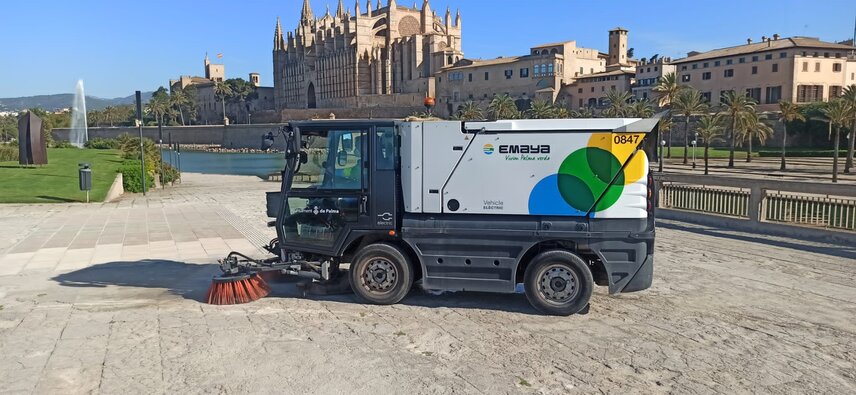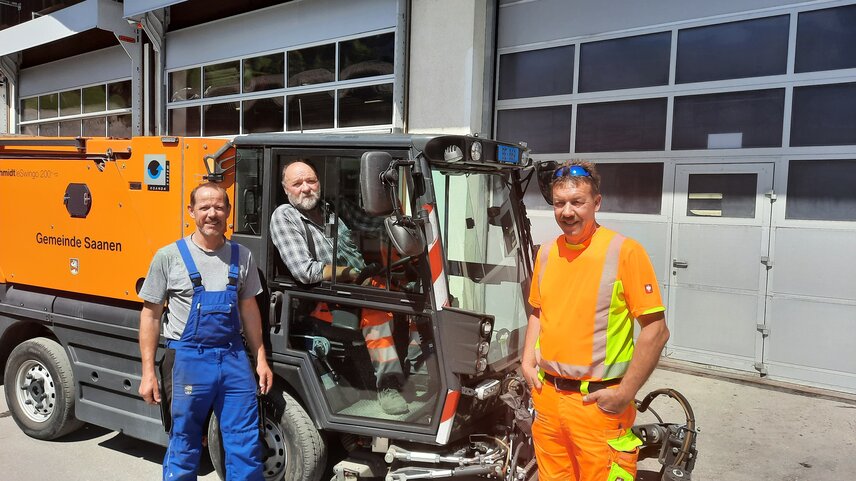Once the battery is charged, the fully electric eSwingo 200+ works for a good 10 hours until the next charging cycle. With fast charging systems and clever recuperation technology, operational readiness can be maintained continuously over several shifts without having to adjust the operational concepts. Electrically powered sweepers even make deployment planning more flexible because, for example, costly refuelling trips are no longer necessary. The advantages are obvious:
- emission-free operation reduces CO2 emissions on a daily basis
- the lower noise emissions please both drivers and residents alike
- the lower total cost of ownership is easy on the budget
- the reduced maintenance effort frees up resources for other things
- service and diagnosis of the battery is carried out by Aebi Schmidt, as well as free take-back and recycling.
All these advantages apply without compromising on performance and without having to forego the modular equipment, the diverse expansion options and the ergonomic design of the cab.
But does what we present here correspond to practical experience? Do the electrically powered sweepers prove themselves in everyday use? We wanted to hear from those who know what they’re talking about. Below are the accounts from relevant people in three very different-sized municipalities in Spain, the United Kingdom and Switzerland.

Palma de Mallorca (Spain): 400,000 inhabitants | Fleet of 30 compact sweepers | 1 electrically powered eSwingo 200+ in operation for 15 months
In Palma de Mallorca, Emaya is responsible for keeping the streets and pavements of the capital clean and safe. Two years ago, the company set itself the goal of making its activities and operating processes as ecological and sustainable as possible. In this context, Emaya also procured an eSwingo 200+. The drivers and service managers are very satisfied with the electrically powered model. The eSwingo 200+ is used in Palma de Mallorca mainly in the city centre, because that is where the benefits of emission-free operation and lower noise are greatest, especially in the historic old town. Integration into the fleet went smoothly. Emaya appreciates not only the advantages in operation but also the lower maintenance costs. The maintenance interval is at around 1,000 operating hours, which is twice as long as with a diesel model. Since special qualifications are needed to handle electrical components, Emaya trains its mechanics and drivers accordingly. In Palma de Mallorca, this is seen as an investment in the future, because – as Emaya says – there is no way back.

Southampton (United Kingdom): 250,000 inhabitants | Fleet with 11 sweepers, 8 of which are Schmidt compact sweepers | 5 electrically powered machines | 4 eSwingo 200+ machines in operation since December 2020
The integration of the new electric sweepers didn’t require any change in operations in Southampton and the expected benefits have been fully realised in practice. To keep the eSwingos on the road and fully charged, charge points have been installed at council depots. This was not only for the sweepers, but in the context of the City Council’s sustainable energy and carbon reduction objectives, which include a pledge to be carbon-neutral by 2030, and that all corporate assets will have a net zero carbon footprint and 90% of the fleet will be zero-emission by 2030. Mark Winter, Southampton City Services Supervisor, explained: “The zero-emission sweepers not only offer cleaner air for pedestrians but also for the driver in the cab. They are smooth to drive and are much quieter than the diesel vehicles, which is great for residents when we’re making early starts or passing by in the street. The battery life of the vehicles is excellent, and the payload is increased by 500 kg. Service intervals are also further apart so we have less downtime. As well as this, we’ve found that the fan speed is less variable in the electric vehicles which improves suction, making street sweeping more effective.” Furthermore, in addition to the significant overall environmental benefits, it became evident in just a few months that the savings on diesel quickly translate into lower operating costs.

Saanen/Gstaad (Switzerland): 6,800 inhabitants | 1 electric eSwingo 200+ compact sweeper in operation for about 12 months
In Saanen/Gstaad, no adjustments to the operational concept were necessary. From day one, the eSwingo 200+ was able to operate the same routes as previously with the diesel machine. No special measures were necessary to integrate the eSwingo 200+ into the fleet either. For the drivers, working has become more comfortable, as it is considerably quieter in the cab compared to the diesel model. “Before the purchase, there was some scepticism as to whether the electrically powered model would deliver the performance we were used to,” says Hanspeter Hefti, deputy operations manager. “But our drivers quickly realised that no significant changes were needed and that the handling and operation were identical to the diesel model,” says Hefti, adding: “Only in terms of driving style did we advise our drivers to drive more consciously and economically, for example to reduce the turbine speed when full power is not required. That way we can conserve battery power.” While the cost savings are naturally limited after only the first year of operation, the massive savings in the diesel that has been eliminated are already apparent and of course very welcome. The conclusion of the team in Sannen/Gstaad after the first year of operation: “A diesel-powered sweeper would no longer be an option in the future.”
